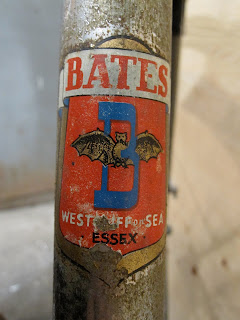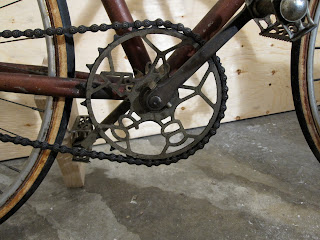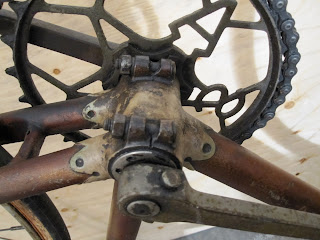






Finding interesting old bikes used to be an easy thing. When I first began obsessing about classic racing bikes there was no E-bay or craigslist, in fact, there was barely even the internet. I would find nice bikes at junk stores, Goodwill, and yard sales. Working for years as a mechanic at various shops around Toronto I would always grab the interesting trade-ins that would come through the doors. Finding parts was usually difficult but, for the most part, local shops stocked some weird, left-over, out-dated and defunct parts (now commonly labeled NOS) that they didn't really want around and would eagerly sell for a reasonable price. Mountain bikes were still king, road bikes in the city were rare and very ,very few cyclists road anything with a fixed gear. Old road bikes really didn't have much value to most people. As an enthusiast, I would even have a hard time figuring out what something was worth or even what it was for that matter. But, things are different now, as the internet and the online marketplaces of Ebay and Craigslist have changed everything. It is far easier these days to find any part you need and to research vintage bikes but, it is also harder to afford anything, as Ebay prices are basically in Yen and most local sellers now seem to think anything old is a "collectable" worth a fortune.
The biggest change though, and the one that I see as the inevitable result of this new massive marketplace, is the dismantling of original bicycles so they can be sold for more money as parts. This "parting out" is not new, but now that there is an easy outlet to sell the parts and you can double your money by selling this way it has become rampant. I try hard not to support dealers who practice this as it seems particularly greedy to me and it is basically destroying a huge number of nice bikes, but on a few occasions I have been forced to buy from one of these tacky people by an item that was just too interesting to ignore.
I found this early 1940's Bates "Best all Rounder" as a frame and fork on british Ebay and was surprised, as was the notorious seller, that my very low bid won. I had always wanted to see a Bates in person as it has a few features that make it unique and highly innovative for its time.
Unlike today, bicycle tubing in the thirties was available in a limited number of sizes and most builders used the established norms of a 1" top tube and a 1 1/8" down and seat tube. Bates decided that this created a frame that was too flexible or "whippy" and what was needed was tubes of a larger diameter which, by definition would be stiffer. It wasn't just as simple as using bigger tubes though, as the common joining method of the tubes were lugs, which were all made to fit only the traditional sizes. To overcome this, Bates had Reynolds Tubing make special "Cantiflex" tube-sets that had oversized middle sections and standard ends. It is barely noticeable in photographs but in person it is quite dramatic.
The second innovation is the unique double bend "Diadrant" fork blades. These were designed to attempt to achieve a more responsive steering but were probably more of a branding exercise. Apparently, in the thirties and forties most British cycling clubs forbid any type of sponsorship for racers and so the distinctive forkblades would be a clever way of getting around this by letting everyone know who was winning on Bates machines.
As I received the frame and fork with only a headset and bottom bracket attached I decided to build it up as a non-historically correct bike which reflected more of how I wanted to use it then how it would have been in the forties. I used a fifties Sturmey Archer alloy three-speed hub which is vaguely correct but for the most part, it is just classic parts that work well together.
When I first rode it, I was amazed at how stiff the almost 70-year-old frame rode. Paired with the long top-tube geometry that Bates used, this stiffness actually makes it an uncomfortable bike to ride casually but a responsive, and fast sprinter.
Nowadays, for the same reason Bates did, most road bike manufacturers use oversized tubes and Pinarello even uses a variation on the Diadrant fork bend. The Bates B.A.R. was way ahead of its time and, in fact, even though it is one of my oldest bikes, its super-stiff ride is perhaps a little too modern for me.































